Surface shooting and other portable techniques were introduced to Canada to eliminate the impact of "dozing" wide seismic lines in beautiful and fragile terrain. The Foothills are not only a petroleum province with hydrocarbon resources in the many billions of dollars, but an area of scenic beauty without compare which it is our duty to pass on to future generations. In our search for hydrocarbons, we must tread gently. This article discusses the technical aspects of one approach.
In a recent article, SAFETY JACK referred to what many call "Poulter shooting" - but the technique we use is not Poulter shooting. Poulter's work goes back years and years. The files which I had on Poulter shooting are now lost, so what I write on his technique is based on memory only. So far as I recall, his work was done in the 1940's - recording instruments had glass "tubes" flowing cherry red and gave off a steady hum of electricity. I doubt if 24 channel recording had come in by then probably the typical set of instruments had 6, or wonders, 12 channels! Geophones were weighty affairs, a few pounds apiece, so laying out more than one per trace was rarely done.
The typical Poulter shot - going by what his patents said - had a dozen or more charges of 10-25 Ibs erected on poles 10-15 ft up. The poles were spaced quite far apart, as much as 25 ft or more.
Poulter claimed that the SHOCK waves given out by the separate charges would combine to produce a downward "shock-jet", which would strike the ground, giving more energy (Fig. 1). This claimed reinforcement of the shock waves was the whole basis of Poulter's patent claims.
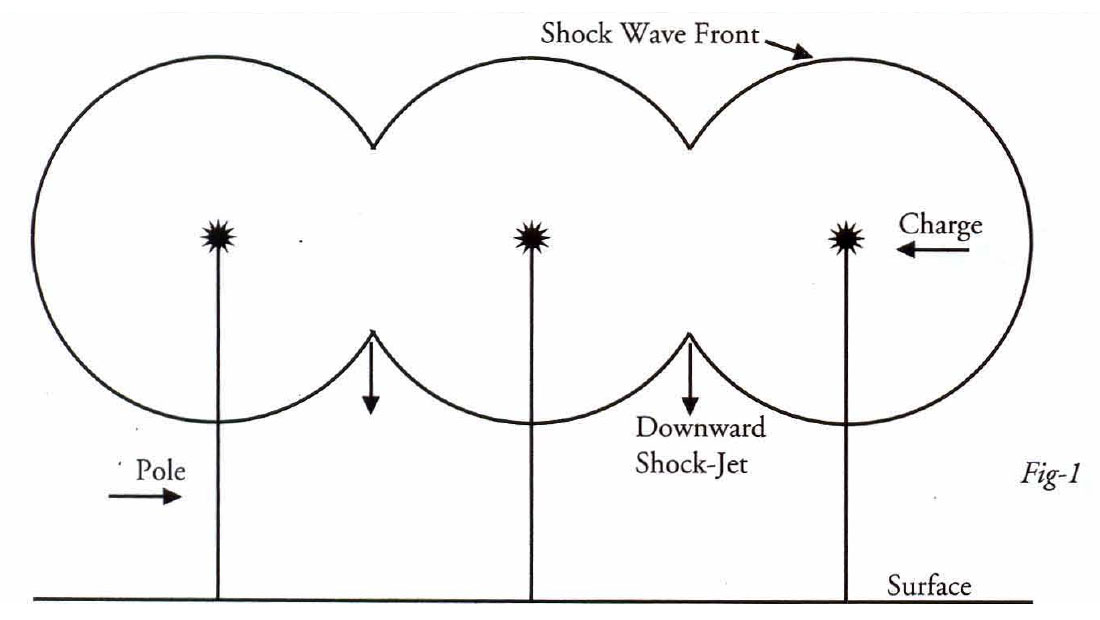
From what I gathered many years ago, no one else could quite make his methods work in the way he claimed.
Do shock waves combine to form "shock-jets"? Yes they do - this is the whole principle behind shaped charges which can drill neat holes through thick steel. When two shock waves collide head-on, they demolish themselves, the energy goes sideways. Shock waves, by definition, are inelastic waves travelling above the speed of sound and so behave differently from acoustic waves. Shock waves coming out from an explosive start at a high velocity, typically 5000 to almost 7000 metres/sec ... as they travel outwards, the velocity drops progressively (loosing energy by smashing the rock) until the shock wave degenerates into an acoustic wave, which then travels on at a constant velocity. Acoustic waves do not smash rock, the rock is unharmed after the passage of an acoustic wave. When acoustic waves collide, they pass through each other, as if the other acoustic wave were not there.
Poulter's claims are problematical, for several reasons:
- The shock waves collide to form "shock-jets" upwards, sideways too, in fact over the whole 360 degrees. So no more energy is directed downwards, compared to any other direction (Fig.2).
- Shaped Charges also cause intense "jet action". Every five years or so, it is claimed that Shaped Charges "direct" seismic energy downwards. However, when carefully controlled tests are carried out with shaped charges, all of the extra energy is found to be due to the different explosive formulas used for shaped charges (and other factors), and not the shaping process itself. So the claim that "jet action" can give more seismic energy is unproven.
- "Shock-jet" waves from explosives cause intense local damage. Only a few percent of the total energy of a seismic explosive goes on to form acoustic P-waves - nearly all is lost in the form of heat and broken rock. Compared to an ordinary charge more damage is caused which is liberated in the form of more heat. The result is that less energy remains to be transmitted as seismic energy.
No one seemed to be able to duplicate Poulter's claim of increased seismic energy. Clearly Poulter did observe something, so what was it?
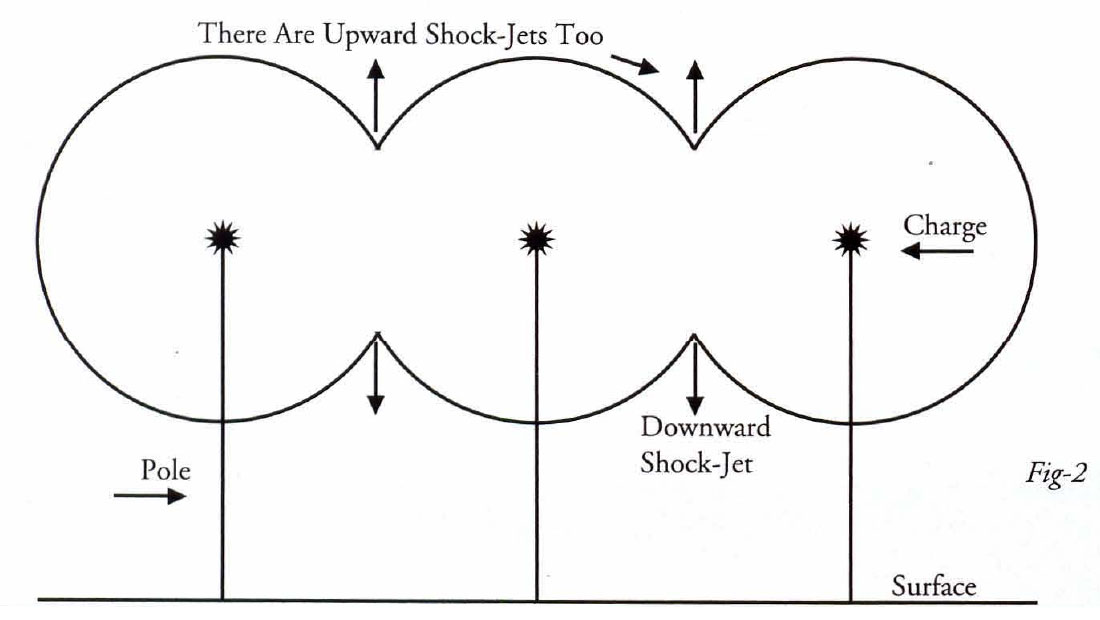
Having done extensive work on surface shooting source design and the mechanisms of generation of seismic energy when explosives are fired unconfined, I'm convinced that the whole Poulter thing is based on a misconception, which was pretty well impossible to detect in Poulter's day, with the state of instrumentation at the time. However, not only Poulter has fallen into the same trap ~ many other geophysicists have too, when doing surface shooting. Did Poulter (and others) get more "energy" on the record? Yes, but the increased energy is not just signal but signal+ noise - the noise so resembles signal that many have been deceived.
The sound and smoke of a surface shot is just temporary. The attraction of surface shooting, with proper field design and procedures, is that we can acquire quality seismic in sensitive, beautiful and rugged areas, and yet it is difficult to see where the seismic crew has been. Even when you know the location of a portable surface shot seismic line, very often you really have to search to find it - truly low impact seismic acquisition. With correct parameters, surface shooting can give really good results at a lower cost and lower impact than other methods - with poor parameters the results can be appalling and very costly!
The air blast from a surface shot sounding just like thunder at a distance is the origin of many problems for surface shooting, unless we design our field parameters carefully.
- We must offset our first live trace to a distance so that the deepest reflection of interest arrives before the air wave.
- The air wave, as it "rolls" across the ground, strikes trees, rocks, cliffs - anything in its way. Given half a chance, this air wave energy will dive into the ground. It may manifest itself as ground roll, or as P or S waves at the same velocity as the near surface. These secondary source waves may travel away from the shot or can be reflected backwards towards the shot (Fig. 3).
This SECONDARY SOURCE EFFECT produces coherent, downward dipping, events at a distance – say 1000 or 2000 m offset. In Foothills work it is often very difficult to see coherent reflectors at all. So imagine the joy of many a client when they see a strong event that has all the features of a real reflector. They then choose the field parameters that seem to enhance what appears to be reflectors – little realising that the parameters have been optimised to give the best noise. - It is frequently very difficult on a normal production reflection spread record to distinguish between SECONDARY SOURCE events and real reflectors.
- SECONDARY SOURCE events have static shifts as they follow the rugged terrain up and down. They may also change layers, so changing velocity. Generally they follow the first breaks in character and velocity - but there is no guarantee of this. Hence these "nuisance" events can be both straight or may look curved, just like a reflector! (Fig. 4).
- Because of steep subsurface dips, real reflectors often have less curvature than in level country, and have lower apparent velocities than normal. With the long offsets in surface shooting, we have less to see of the "flat" part of the NMO reflector curve. So these "nuisance" events can look just like a real reflector (Fig. 5).
- Very frequently a real reflector can combine with and appear to be reinforced by one of these "nuisance" events. The curved part of the combined event may be a real reflector, but the straighter pm1 at longer offset may be part of a secondary source event (Fig. 6).
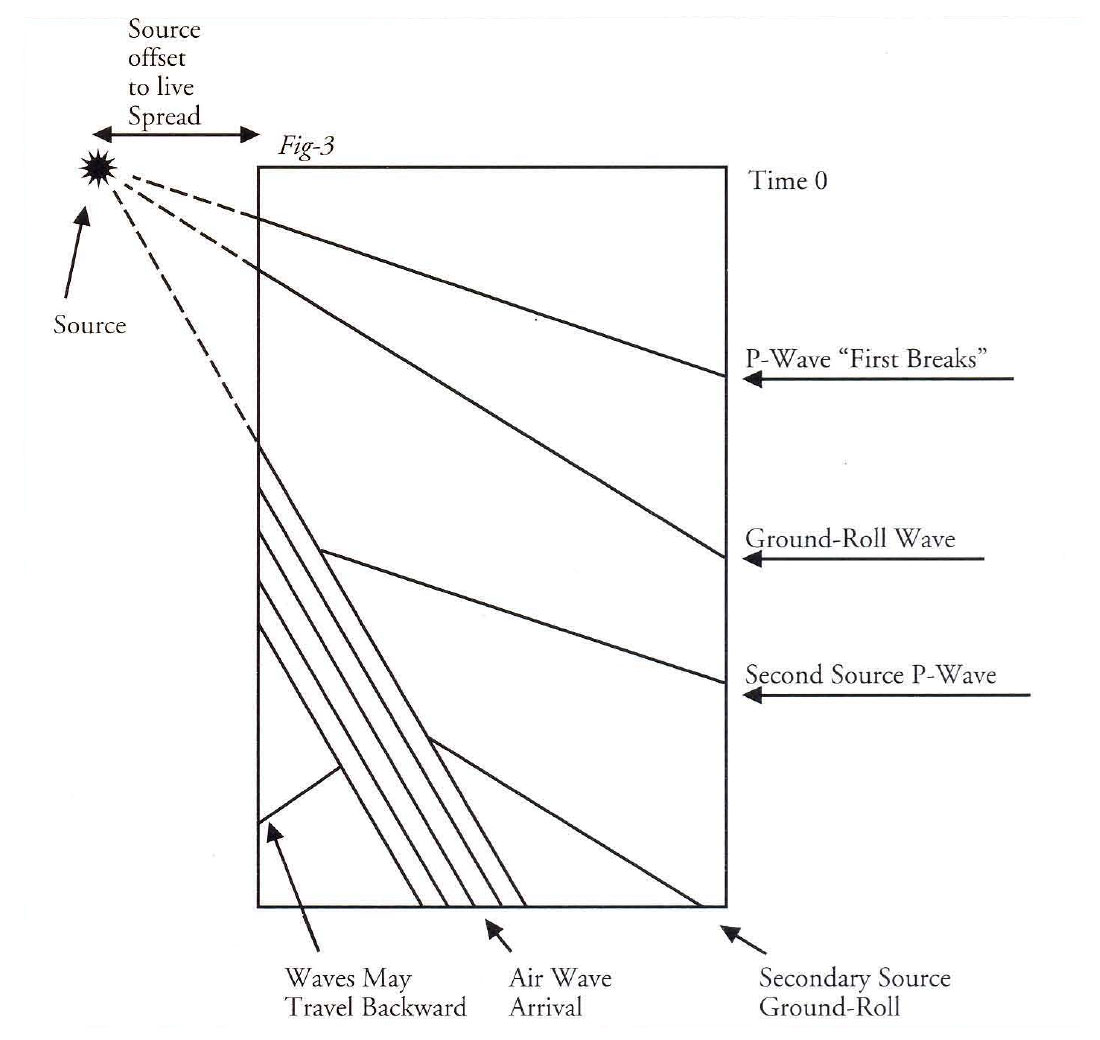
The energy of these secondary source events is influenced by the air wave, which in turn is affected by the interplay of several factors at the shot:
- height of the charges above the ground
- size and number of charges
- composition of the explosive
- horizontal distance between the charges
- temperature
- how the charges are initiated
- the exact nature of the ground under the shot
- wind direction.
How these events appear on the record depends on a number of factors at the receiver end:
- geophone array
- how well buried the geophones are
- the nature of the ground on which the spread is laid
- the type of vegetation at the receiver.
Doing tests according to the "instructions" in his patent, I found that these secondary source effects were greatly increased in amplitude. Reflectors were made weaker.
The same quantity of explosive used in different and better ways resulted in as much as five to ten times lower secondary source events, as well as higher reflected energy. These events do not stack out well except at high fold, simply because they are very similar to real reflectors. In Poulter's day he would have worked with individual records, since stacking had probably not been thought of then. With the trace spacings and limited number of channels available to Poulter, he would not have been able to see what we can now – all he would have seen would have been what looked like more solid reflectors.
These days it is tough to justify money spent on testing. The explosives industry - the air wave energy increases (as shown by instrument over-scaling or amplitude measurements on the air blast window). This in turn increases secondary source effects so that signal : coherent noise ratio decreases.
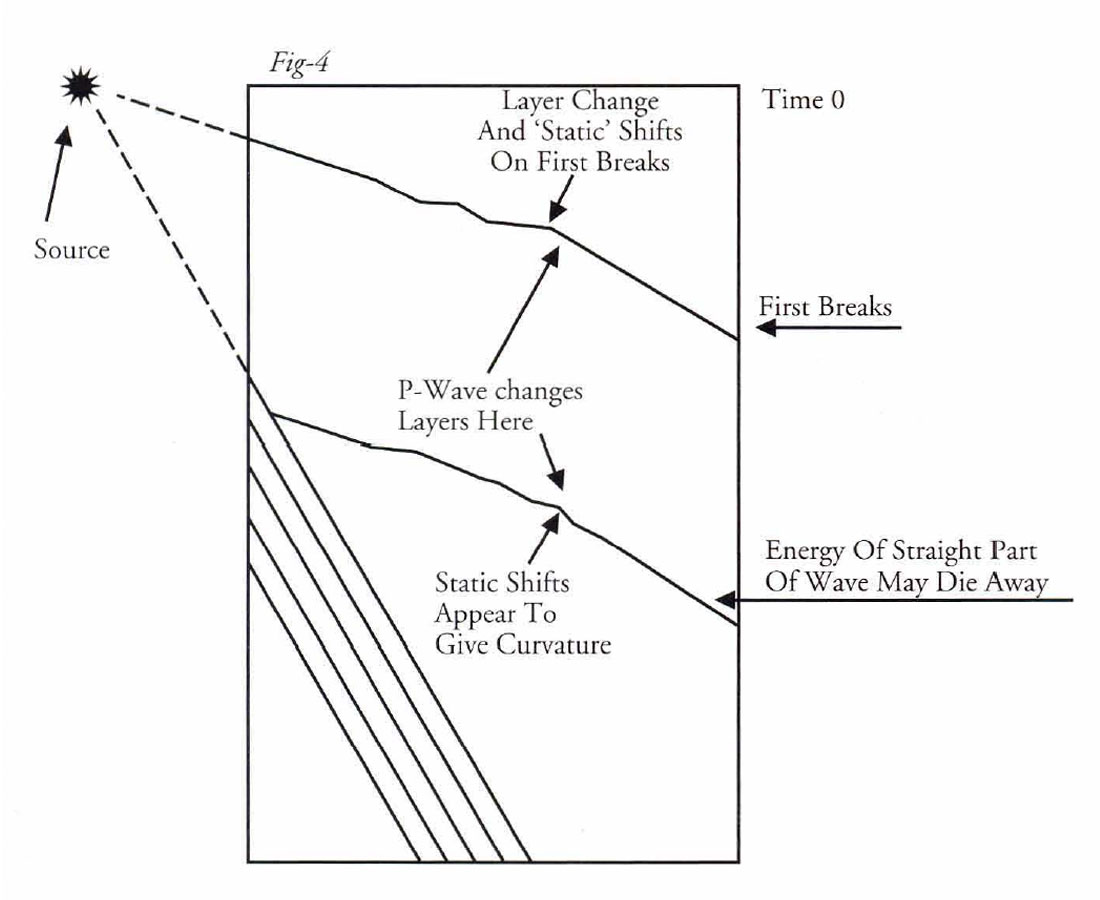
Thus elevating the charge more than the minimum to avoid ground damage is not a good idea – it wastes money on more explosives and decreases record quality.
The distance at which degradation of quality begins (the "critical height") depends on:
- charge size
- charge formulation
- charge spacing
- method of initiation
- temperature
- ground conditions.
Normally, good surface contact of an explosive gives the best transmission of the energy and so more signal - the acoustic impedance of the explosive matches fairly closely that of the ground. However an explosive in contact gives a high shock pressure which crushes the surface, thus wasting explosive energy inelastically in the form of heat. As the explosive is raised, a gas "layer" is introduced, thus an acoustic impedance miss-match occurs. This reduces the energy transmission - but this effect is nearly offset by better conversion efficiency as less explosive shock energy is lost in crushing the rock. In effect, the gas layer introduces a "cushion" between the charge and the ground, which spreads the energy over a wider area, thus lowering peak ground loading.

This mechanism explains why raising the charges a small distance, alters the seismic signal very little. As soon as we go higher than the "critical height", then we loose more and more signal with increasing height. At the critical height, the peak ground loading is probably approximately the same as the elastic compressive limit of the ground material.
The air wave amplitude increases directly with height - with any elevated charge it is important to use array design to minimize the type of air wave which causes secondary source effects - regrettably this factor is usually overlooked.
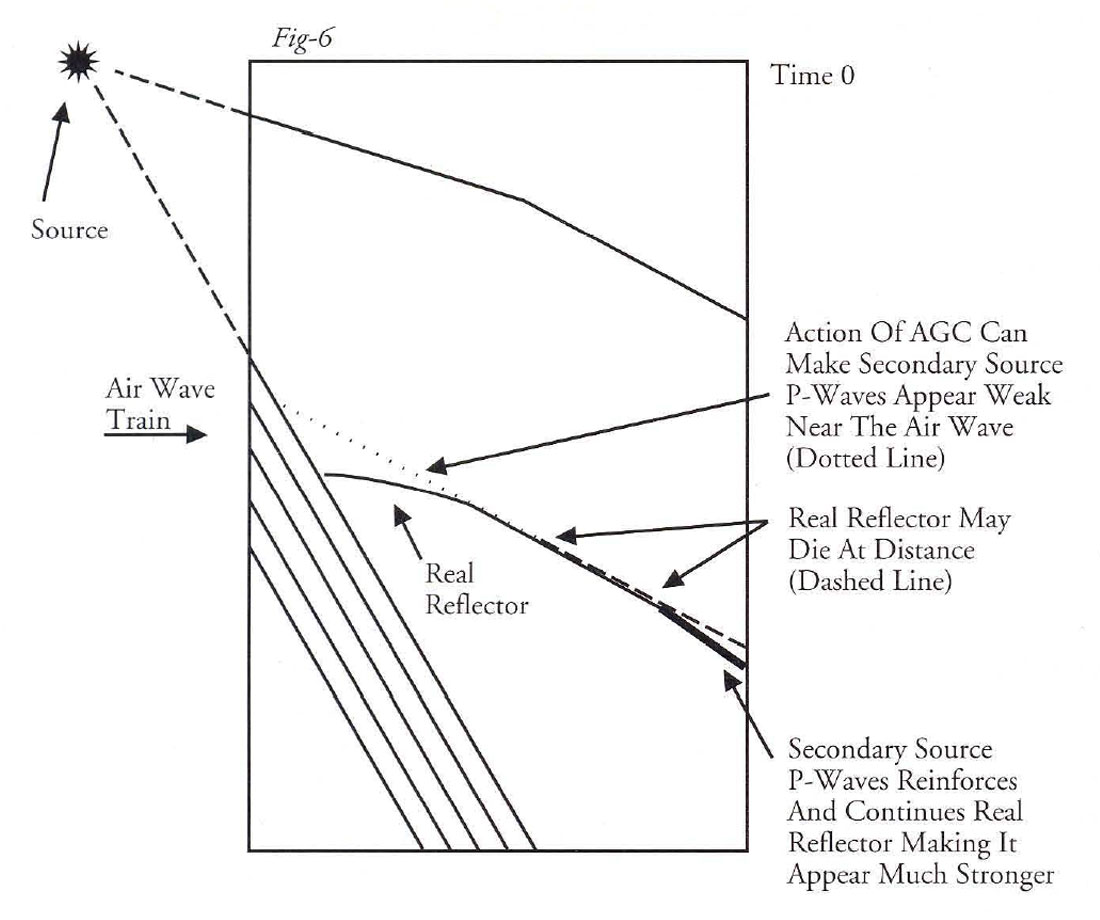
Finding out the "critical height" and array design to reduce secondary source events is important in terms of dollars spent and on record quality.
Shooting surface on lath to avoid surface damage is not Poulter shooting as we never get high enough for the supposed benefits of Poulter's colliding shock waves to form – why don't we call it POLE SHOOTING instead?

Acknowledgements
Graphics by MacdanaldCole Inc.










Join the Conversation
Interested in starting, or contributing to a conversation about an article or issue of the RECORDER? Join our CSEG LinkedIn Group.
Share This Article